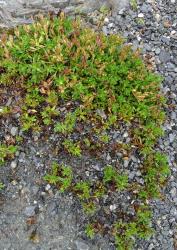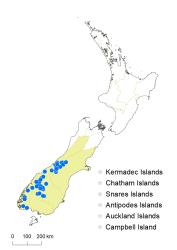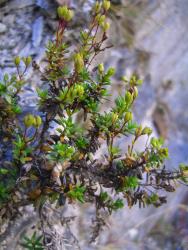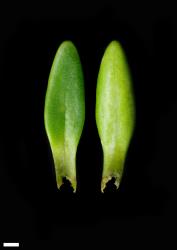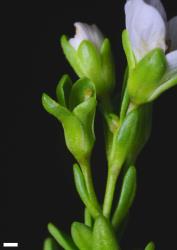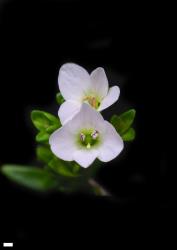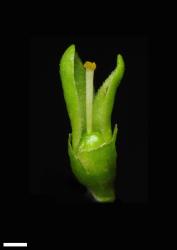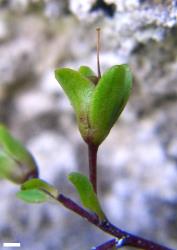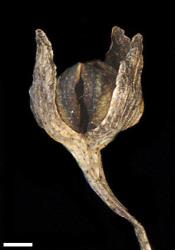- = Parahebe linifolia subsp. brevistylis Garn.-Jones, New Zealand J. Bot. 14: 288-289 (1976) nom. nov.
- ≡ Parahebe brevistylis (Garn.-Jones) Heads, Bot. J. Linn. Soc. 115: 72 (1994)
Sub-shrub to 0.15 m tall. Stems trailing to erect, glabrous or eglandular-pubescent; hairs bifarious on distal portion of internodes. Leaf bud indistinct; leaves separating while small, opposite-decussate, erecto-patent to recurved; lamina sub-coriaceous, linear to narrow-oblong, 4–15 mm long, 1–3 mm wide, glossy green above, dull pale green to purplish beneath; midrib evident; surfaces glabrous; margin ciliate towards base, entire; apex rounded to truncate; base cuneate; petiole 1–3 mm long. Inflorescence a lateral raceme, 10–40 mm long; flowers distant, 2–6, all bisexual; bracts alternate, linear to narrowly elliptic, < pedicels; pedicels erecto-patent to sub-erect, incurved at fruiting, 4–15 mm long, glabrous. Calyx lobes 4, obtuse to sub-acute, 3–8 mm long, sub-equal, glabrous. Corolla 5–10 mm diameter; tube white, 1.2–3.5 mm long, < calyx, glabrous inside; lobes 4, white, erecto-patent, sub-equal, elliptic to ovate, 4–7 mm long, sub-acute to obtuse; nectar guides absent or rarely 2–4, pink, on posterior lobe only. Stamen filaments white, 1–3 mm long; anthers pink to magenta. Style glabrous, 2–4 mm long. Capsules angustiseptate, truncate to emarginate, glabrous, 3.5–4.0 mm long, 3.5–4.0 mm at widest point. Seeds ellipsoid, flattened, smooth, brown, 0.5–0.9 mm long.
V. colostylis is difficult to distinguish from V. linifolia unless flowers or fruits are present, when its smaller flower parts, especially the filaments and style, and the smaller corolla, which doesn’t open so widely and has a glabrous tube, will distinguish it. Also, the corolla almost always lacks the coloured nectar guides of V. linifolia (Garnock-Jones 1976a, 1981). These two are easily distinguished from all other species by their linear, entire, glossy green leaves combined with their low sub-shrub habit.
| colostylis | linifolia |
|---|---|---|
Leaf length (mm) | (5–)8–12(–15) | (10–)12–20(–30) |
Pedicel length (mm) | (4–)6–12(–15) | (8)–13–30–(40) |
Corolla | white, nectar guides absent or rarely faint, pink, on posterior lobe. | white or pale blue (rarely pink), with magenta nectar guides on posterior and lateral lobes. |
Stamens | erect; filaments 1–3 mm long | diverging; filaments (4)–6–8 mm long |
Style length (mm) | 2–4 | (4)–6–8(–9) |
Veronica colostylis plants are sometimes misidentified as V. planopetiolata. V. planopetiolata plants can be distinguished by their mat-forming habit, leaves that are often broader (up to 6 mm wide), and usually shallowly crenate although sometimes entire, flowers usually paired but sometimes solitary, on short peduncles 1–2 mm long below the bracts; the capsules are often held at the surface of the plant mat, and are hygrochastic (open when wet); the seeds are often slightly larger, 0.8–1 mm long.
South Island: Westland (from Whataroa River south), Canterbury (western parts from Rangitata River south), Otago (west), Southland (west), Fiordland. A specimen from Camp Creek, Alexander Range, Westland (CHR 521968), is probably V. colostylis, which suggests its distribution overlaps with that of V. linifolia. There are specimens of V. linifolia also from Mt Alexander.
Montane to alpine cliffs, rock outcrops, river gravel, river banks, moraines, sometimes in grassland, commonest near the Main Divide. Recorded elevations range from 220 to 1585 m.
Flowers: October–March; fruits: November–April, persisting all year.
2n = 42 (Hair 1970, as Parahebe linifolia).
Veronica colostylis is classified in V. subg. Pseudoveronica sect. Hebe and informally in the “speedwell hebe” group (Albach & Meudt 2010). V. colostylis and the very similar V. linifolia appear to belong with V. lyallii and several other species in a clade (the speedwell hebes, Albach & Meudt 2010) that is characterised by short corolla tubes, nectar guides on the corolla, and rather lax inflorescences, although V. colostylis usually lacks nectar guides. Most species in this grouping also have flowers with plicate lateral corolla lobes, which enfold the stamens, but flowers of V. linifolia and V. colostylis, along with those of V. lilliputiana and V. jovellanoides, lack them.



